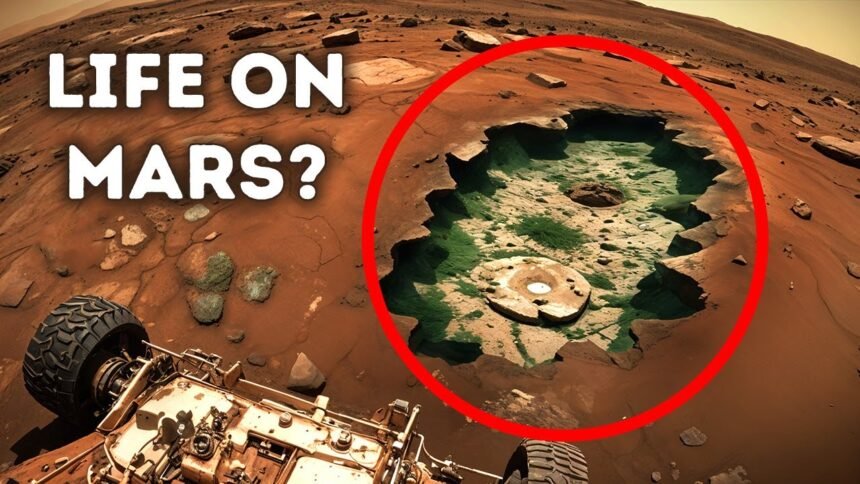The idea of life on Mars has fascinated humans for generations. Are we alone in the universe, or could there be life lurking somewhere beyond our own planet? Recent NASA research brings us closer to unraveling this cosmic mystery, and it’s not as far-fetched as it once seemed. According to new findings, the mid-latitude regions of Mars could potentially harbor conditions that allow for photosynthesis. Yes, you heard that right—photosynthesis on Mars! Could this mean the presence of alien life? Let’s dive in and explore what this breakthrough means.
What Are Mars’ Mid-Latitudes?
Before we get too excited, let’s break down what we mean by “mid-latitudes.” Mars’ mid-latitudes refer to areas situated between 30 to 60 degrees latitude in both hemispheres. These regions are thought to contain substantial amounts of water ice hidden beneath the surface. Imagine water, lying quietly under several meters of thick, dusty materials. Sounds like the stuff of science fiction, right? Well, the reality might not be that far off.
The Role of Photosynthesis
To understand why this is such a big deal, we need to talk about photosynthesis. On Earth, photosynthesis is the process that allows plants, algae, and certain bacteria to use sunlight, carbon dioxide, and water to produce oxygen and glucose. It’s a fundamental life process, not just for plants but for all oxygen-breathing organisms. Photosynthesis is responsible for a large portion of the oxygen in Earth’s atmosphere, and without it, we wouldn’t be here.
Mars and Photosynthesis: A New Frontier?
So, what does this have to do with Mars? According to NASA’s research, photosynthesis might be possible under the icy layers in Mars’ mid-latitudes. The thick ice could protect potential life forms from the Sun’s harsh radiation while still letting in just enough sunlight to support photosynthesis. It’s like creating a greenhouse effect, but under ice! The possibility of these so-called “radiative habitable zones” opens up a whole new field of exploration.
Aditya Khuller’s Insights on Martian Life
One of the study’s lead researchers, Aditya Khuller from NASA’s Jet Propulsion Laboratory, shared some fascinating insights. He explained that the Martian ice exposures might be the most accessible places to search for Martian life today. Of course, this doesn’t mean we’ve found life on Mars—yet. But Khuller’s research gives scientists clear direction on where to look next.
“We’re not saying we’ve found life on Mars, but we believe these dusty ice exposures in the mid-latitudes are the most promising areas to search for it,” Khuller stated in an interview with Space.com. Imagine that: beneath layers of ice, hidden in Mars’ cold and barren landscapes, we might find life.
Earth vs. Mars: A Habitable Zone Comparison
One of the reasons Mars and Earth have long been subjects of comparison is because both planets exist in the Sun’s habitable zone. This zone is where temperatures are just right for liquid water to exist. While Earth boasts vast oceans covering over 70% of its surface, Mars isn’t as lucky. However, the discovery of ancient water bodies, such as dry lake beds and water ice deposits, suggests Mars was once much wetter than it is today.
The Mystery of Mars’ Lost Water
So, where did all of Mars’ liquid water go? According to scientists, Mars lost its liquid water billions of years ago when its magnetic field collapsed. Without this protective shield, the planet was exposed to harmful ultraviolet radiation, leading to the evaporation of its water sources. Currently, Mars experiences 30% more ultraviolet rays than Earth, thanks to its lack of an ozone layer.
Could Water Still Exist Beneath Mars’ Ice?
Here’s where things get even more interesting. NASA’s study used computer simulations to model the conditions beneath Mars’ icy surface. These simulations suggest that the dusty ice could trap heat and cause internal melting, forming pockets of liquid water. This is crucial because, as we know, sunlight and liquid water are essential ingredients for photosynthesis. According to Khuller, it’s possible that these conditions could exist just beneath the surface ice, keeping the dream of finding life on Mars alive.
Radiative Habitable Zones: What Are They?
The term “radiative habitable zones” refers to areas on Mars where ice could simultaneously block harmful radiation and allow enough sunlight to penetrate, creating a safe environment for life forms. Think of it like a cosmic greenhouse, where the ice acts as a protective layer while still letting in light. If these zones exist, they could be the key to finding life on Mars, even if it’s microscopic.
What Does This Mean for Future Mars Missions?
NASA’s new research has important implications for future missions to Mars. Now that scientists know where to look, the focus will likely shift toward exploring these mid-latitude regions more closely. It’s like having a treasure map, and we’re getting closer to X marking the spot. The next step? Sending advanced missions to these icy locations to search for microbial life or other signs that Mars once supported life.
The Bigger Picture: Are We Close to Finding Life Beyond Earth?
The search for extraterrestrial life has always been one of humanity’s biggest questions. While we’re still far from definitive proof, NASA’s research suggests we might be on the right path. The idea of life on Mars isn’t just about finding Martian microbes. It’s about understanding whether life can exist elsewhere in the universe. If we can find life on Mars, what does that mean for planets outside our solar system?
Read More: Sunny Deol Jaat Movie: A High-Octane Action Flick Drawing Mixed Reactions- Click Here
Conclusion
In conclusion, NASA’s groundbreaking research brings us closer to answering the age-old question: Are we alone in the universe? While we haven’t found life on Mars yet, the discovery of potential photosynthesis zones beneath Mars’ icy surface is a huge step forward. Imagine what this could mean for future space exploration. Could the red planet hold the key to unlocking the secrets of extraterrestrial life? Only time, and more missions to Mars, will tell.
As we continue to study Mars and its unique conditions, one thing is clear: we’re on the cusp of a new era in space exploration. The possibility of finding life, even if it’s just microscopic, opens up endless possibilities for the future of humanity and our place in the cosmos.










